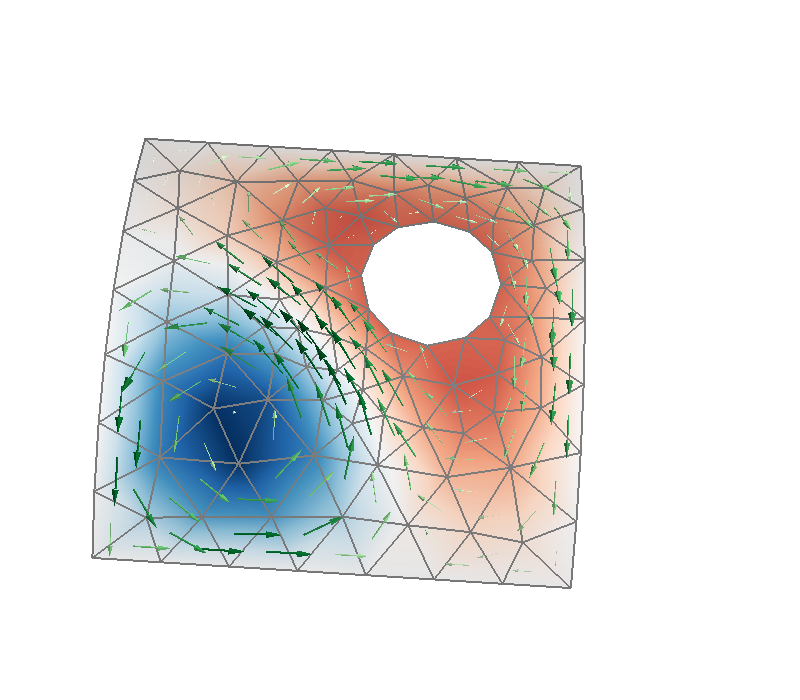Note
Click here to download the full example code
Figure 1: Stream function example¶
An example stream function (red–blue colormap) and its rotated gradient, i.e. the surface current density (arrows; green colormap) on a surface mesh with a hole in it. The surface normal is oriented up towards the reader.

Out:
Calculating surface harmonics expansion...
Computing the laplacian matrix...
Computing the mass matrix...
from bfieldtools.mesh_conductor import MeshConductor, StreamFunction
import pkg_resources
from bfieldtools.mesh_calculus import gradient
import numpy as np
SAVE = True
SAVE_DIR = "./Streamfunction gradient/"
c = MeshConductor(
mesh_file=pkg_resources.resource_filename(
"bfieldtools", "example_meshes/curved_surf_w_hole.stl"
),
process=True,
basis_name="suh",
N_suh=10,
fix_normals=True,
)
T_x = 1.5 * np.pi / 2
T_z = -1.02 * np.pi
rotmat = np.array(
[
[np.cos(T_z), -np.sin(T_z), 0, 0],
[np.sin(T_z), np.cos(T_z), 0, 0],
[0, 0, 1, 0],
[0, 0, 0, 1],
]
) @ np.array(
[
[1, 0, 0, 0],
[0, np.cos(T_x), -np.sin(T_x), 0],
[0, np.sin(T_x), np.cos(T_x), 0],
[0, 0, 0, 1],
]
)
c.mesh.apply_transform(rotmat)
s = np.zeros((c.basis.shape[1],))
s[2] += 1
# s[63] += 2
s = StreamFunction(s, c)
from mayavi import mlab
from mayavi.api import Engine
engine = Engine()
engine.start()
f = mlab.figure(None, bgcolor=(1, 1, 1), fgcolor=(0.5, 0.5, 0.5), size=(800, 700))
s.plot(figure=f, ncolors=256)
c.plot_mesh(representation="wireframe", figure=f)
j = gradient(s.vert, c.mesh, rotated=True)
Len = np.log(np.linalg.norm(j, axis=0))
vectors = mlab.quiver3d(
*c.mesh.triangles_center.T, *j, mode="arrow", colormap="Greens", scalars=Len
)
# vectors = engine.scenes[0].children[2].children[0].children[0]
vectors.glyph.glyph.scale_mode = "scale_by_scalar"
vectors.glyph.glyph.scale_factor = 0.6
f.scene.z_plus_view()
#
module_manager2 = vectors.module_manager
# module_manager2.scalar_lut_manager.scalar_bar_representation.maximum_size = np.array(
# [100000, 100000]
# )
# module_manager2.scalar_lut_manager.scalar_bar_representation.minimum_size = np.array(
# [1, 1]
# )
# module_manager2.scalar_lut_manager.scalar_bar_representation.position = np.array(
# [0.82, 0.1]
# )
# module_manager2.scalar_lut_manager.scalar_bar_representation.position2 = np.array(
# [0.17, 0.8]
# )
# module_manager2.scalar_lut_manager.show_scalar_bar = True
# module_manager2.scalar_lut_manager.show_legend = True
# module_manager2.scalar_lut_manager.scalar_bar.height = 0.8
# module_manager2.scalar_lut_manager.scalar_bar.position = np.array([0.82, 0.1])
# module_manager2.scalar_lut_manager.scalar_bar.position2 = np.array([0.17, 0.8])
# module_manager2.scalar_lut_manager.scalar_bar.width = 0.17
f.scene.camera.position = [
-0.3696892487983681,
0.2840788710848503,
3.701830880912346,
]
f.scene.camera.focal_point = [
-0.3696892487983681,
0.2840788710848503,
0.8575533408480627,
]
f.scene.camera.view_angle = 30.0
f.scene.camera.view_up = [0.0, 1.0, 0.0]
f.scene.camera.clipping_range = [2.5164461179149695, 3.263810326333801]
f.scene.camera.compute_view_plane_normal()
f.scene.render()
module_manager2.scalar_lut_manager.scalar_bar.position = np.array([0.82, 0.1])
module_manager2.scalar_lut_manager.scalar_bar.position2 = np.array([0.17, 0.8])
module_manager2.scalar_lut_manager.scalar_bar.number_of_labels = 0
module_manager2.scalar_lut_manager.scalar_bar.position = np.array([0.82, 0.1])
module_manager2.scalar_lut_manager.scalar_bar.position2 = np.array([0.17, 0.8])
module_manager2.scalar_lut_manager.number_of_labels = 0
module_manager2.scalar_lut_manager.scalar_bar.position = np.array([0.82, 0.1])
module_manager2.scalar_lut_manager.scalar_bar.position2 = np.array([0.17, 0.8])
module_manager2.scalar_lut_manager.scalar_bar.maximum_number_of_colors = 8
module_manager2.scalar_lut_manager.scalar_bar.position = np.array([0.82, 0.1])
module_manager2.scalar_lut_manager.scalar_bar.position2 = np.array([0.17, 0.8])
module_manager2.scalar_lut_manager.number_of_colors = 8
module_manager2.scalar_lut_manager.use_default_name = False
module_manager2.scalar_lut_manager.scalar_bar.position = np.array([0.82, 0.1])
module_manager2.scalar_lut_manager.scalar_bar.position2 = np.array([0.17, 0.8])
module_manager2.scalar_lut_manager.scalar_bar.title = "Current density"
module_manager2.scalar_lut_manager.scalar_bar.position = np.array([0.82, 0.1])
module_manager2.scalar_lut_manager.scalar_bar.position2 = np.array([0.17, 0.8])
module_manager2.scalar_lut_manager.data_name = "Current density"
module_manager2.scalar_lut_manager.label_text_property.shadow_offset = np.array([1, -1])
module_manager2.scalar_lut_manager.label_text_property.italic = False
module_manager2.scalar_lut_manager.label_text_property.shadow_offset = np.array([1, -1])
module_manager2.scalar_lut_manager.label_text_property.color = (0.0, 0.0, 0.0)
module_manager2.scalar_lut_manager.title_text_property.shadow_offset = np.array([1, -1])
module_manager2.scalar_lut_manager.title_text_property.italic = False
module_manager2.scalar_lut_manager.title_text_property.shadow_offset = np.array([1, -1])
module_manager2.scalar_lut_manager.title_text_property.color = (0.0, 0.0, 0.0)
module_manager2.scalar_lut_manager.title_text_property.shadow_offset = np.array([1, -1])
module_manager2.scalar_lut_manager.title_text_property.bold = False
if SAVE:
mlab.savefig(
SAVE_DIR + "streamfunction_gradient.png", figure=f, magnification=4,
)
Total running time of the script: ( 0 minutes 0.804 seconds)
Estimated memory usage: 35 MB
